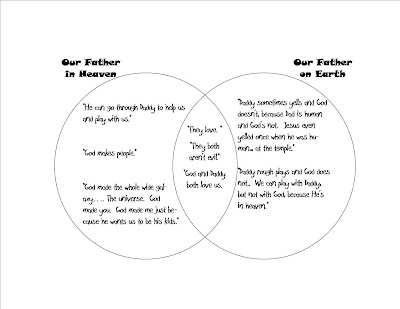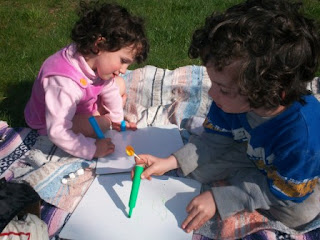 As summer blooms add color to our yard, I am reminded of the
fourth lesson I facilitated in the Read
Aloud to Real Challenges Course that I created for a homeschool co-op a
little over a year ago. The flowers
that the children fashioned in that class (as well as the ones my own children made when I repeated the same class for them at home) were as colorful as the perennial
garden patch in our yard now is. The
attention and creativity with which they created their flowers was equally as
beautiful.
As summer blooms add color to our yard, I am reminded of the
fourth lesson I facilitated in the Read
Aloud to Real Challenges Course that I created for a homeschool co-op a
little over a year ago. The flowers
that the children fashioned in that class (as well as the ones my own children made when I repeated the same class for them at home) were as colorful as the perennial
garden patch in our yard now is. The
attention and creativity with which they created their flowers was equally as
beautiful.
Two ways I continually try to train up my children with
happy hearts are to:
- honor and encourage their
creative genius.
- relate how their creativity is borne of our creator’s genius
The lesson I centered on
The
Plant Sitter and the Garden of Eden aimed to do just that.
- a copy of The
Plant Sitter by Gene Zion
(I believe this book is out of print.
We got our copy from the library and were thrilled with it. If you cannot secure a used or librarycopy
of the book, you could use a book on the same theme, such as Planting
a Rainbow by Lois Elhert.)
- blue paper
- scissors
- yarn
- pipe cleaners
- construction paper
- recycled plastic lids
- tape
- styrofoam trays
- leftover “great stuff” from other
craft and challenge times
- hole punch
- stapler and staples
- white boards and dry erase markers or
scratch paper and writing tools
- a picture book or painting with the Garden of Eden for inspiration
Welcoming
Prayer and Stretch
The same as
in Lesson
Three.
Warm-Up
Challenge: April Showers Bring May Flowers
To set up the challenge, bring out a pile of blue
paper pre-cut into rain drop shapes, cut shapes as you chat with students and
present the challenge, or challenge students to cut some rain drop shapes. In the spring, ask what April showers bring: May flowers.
Or, at this time of year, ask what thunderstorms help: plants and
flowers. Finally, challenge students to
create as many bloom/flower shapes as possible within five minutes using only
the raindrop shaped pieces of paper (and, perhaps, some pipe cleaners.)
As tempting as it may be to guide, model or help
students make blooms, be sure to honor
each child’s creativity by staying quiet during the pause that may occur as
students solve the problems involved with this mini-challenge in their
heads. If a child gets “stuck” and
seems “too” frustrated, simply ask some questions as guidance: Can you name any flowers? How many petals do you notice in such a
flower? What shapes do the petals make?
Etc.
Read
Aloud: The Plant Sitter
Ask children if they can guess
what today’s story might be about. Then,
show the cover
of The
Plant Sitter. Take a picture walk through the story’s
rich illustrations and ask children to predict what they think the story might
be about or ask questions that the text might answer.
Read The Plant Sitter, asking individual children to help read any text that they may be capable of and taking time to stop to really notice the details within the pictures and to make connections and predictions about the story as you go. Be sure to identify what the problems in the story are and what the boy does to solve them.
Read The Plant Sitter, asking individual children to help read any text that they may be capable of and taking time to stop to really notice the details within the pictures and to make connections and predictions about the story as you go. Be sure to identify what the problems in the story are and what the boy does to solve them.
Ask children how the boy applied the strategy for solving
problems that we have used for the
past few weeks. How did he identify his problems, come up with plans for
solving them, test his ideas and, if necessary, adapt his approaches?
For a richer experience, also discuss themes and values related the book—responsibility, hard work, ingenuity, the value of research, etc. Maybe even liken the way the plants grew and grew in the story to the miracle of the loaves and fishes. Isn’t it amazing the way when one child offers meager gifts and talents, plenty can be creates?
For a richer experience, also discuss themes and values related the book—responsibility, hard work, ingenuity, the value of research, etc. Maybe even liken the way the plants grew and grew in the story to the miracle of the loaves and fishes. Isn’t it amazing the way when one child offers meager gifts and talents, plenty can be creates?
The
Main Challenge: Creating A Model of the Garden of Eden
 |
| Planning the Designs |
Note that in the story we read, there were lots
of growing things. If it is winter or spring,
mention that as the weather warms, many folks plan and build gardens. If it is summer, talk about all the growing
things outside. If it is autumn, discus
which plants are still growing and which are dying off for the winter. Ask who can name the parts of a plant (roots,
stem, leaves, petals, seeds). Then ask
if children can think of a Bible Story about a very special garden?
Present the day’s main challenge and its guidelines:
- We will build a model of our own imaginary Garden of Eden.
- It should be a rainbow of colors and contain plants in all
shapes and sizes.
- Each plant must have all its parts (stem,
leaves, petals, seeds, roots).
- Each planet must be freestanding.
- Each plant must be made from materials provided, using the tools provided (which may not actually become part of the construction).
 |
| Creating and Testing Designs |
To encourage students to
plan their model plants out first (as well as to avoid a free-for-all with
materials), let them know they must use white boards and markers (or scrap
paper and writing utensils) to brainstorm.
Once they have sketched their ideas and/or listed the materials they
would like to use to test out their designs, they may collect materials that their plans specifically require.
Once children begin using their
requested materials, if they discover they need other materials, offer them
freely, but ask them what each new material might be used for. As always, encourage children to look
critically at any problems they may run into with their designs and to helps
each other discover ways to overcome these or to revise their plans.
 |
| Challenge Complete! |
Finally, of course, have
students put their plants together to form a garden!
Notes
- If
you wish to add another parameter to the challenge, consider bringing
one-inch cubes. Suggest that plants
may stand no taller than 12 stacked cubes and no shorter than three.
- If any
students finish early, simply extend the challenge by asking them to
create more plants. Or, add related
challenges, such as a suggestion to creatures that could be found in the
garden.
- Inspiration
for this lesson plan came from Planting
a Rainbow at Children’s
Engineering Educators, LLC.
- If
you happen to use ideas from this plan for your own home or classroom,
please point folks back to this post (or
series), and, also, be sure to stop by again with a comment to
let me know how it went. I always
enjoy hearing how others adapt my lesson plans and collaborating to improve
them for future use.
Check out:
·
Lesson One, when Albert’s Alphabet inspired us to build self-standing letters in honor of the Holy Spirit
·
Lesson
Two, when My Friend Rabbit
had us building towers to point to God.

































